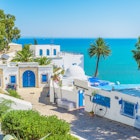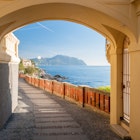
How to hike Mount Etna, Europe's largest active volcano

Oct 4, 2024 • 7 min read

Plan your hike up Sicily's Mount Etna with our top tips. Getty Images
It’s not for nothing that the Egyptian obelisk anchoring Catania’s central piazza supposedly possesses magical powers to temper Mt Etna. Sicily’s second-largest city lives at its mercy. The active volcano – Europe’s largest – buried the city in boiling lava in 1663 and has erupted at least 80 times in the last 100 years. In August 2024, an angry Etna shot a gigantic eruption cloud 10km (6 miles) high in the sky, spewed filthy black ash across cars and sidewalks in the city, and shut down both airports (again) on the Italian island. Little wonder, then, that climbing Mt Etna is no walk in the park.
Despite the hordes that flock to the volcano every year, hiking here is a serious undertaking. The smoke rings that puff gently into a bluebird sky occasionally from one of its multiple craters – four pock its 3369m-high (11,953ft) summit and there are 300-odd lateral craters – might hint at romance, but the reality is far less pretty. The footpath of lava rocks that I picked my way across with a volcanological guide back in July is already long gone, drowned in a new fireball sea of red lava that crashed down from Etna’s peak just weeks after I left. "We built this path by hand, rock by rock, after the last major eruption in December and will no doubt build many more," my guide Mirto explained, handing me a fist-sized nugget of lava to feel, still toasty warm seven months later.
- placement: fullWidth
- path: articles/in-content-top
- possible size: [970, 250], [970, 90], [728, 90], [300, 250], [320, 50], [1, 1],
- targeting:
{ "url": "how-to-hike-mount-etna-sicily", "destination": "Sicily", "continent": "Europe", "country": "Italy", "region": "Sicily" }
Etna is clearly not a mount to mess with. A typical mountain combo of high altitude and capricious weather, uniquely coupled with volcanic activity and a healthy dose of Sicilian hijinks, makes advance planning essential. Here’s how to tackle hiking on Mt Etna safely, soak in its otherworldly moonscapes, and feel the pulse of planet Earth in real-time.

Consider the season and weather
What with sizzling-hot summer temperatures and high-season crowds, Sicily in August is never a brilliant idea. Snow can linger on Mt Etna’s summit well into April and return in November, making the shoulder seasons – April, May, September and October – the best months for hiking. Spring and fall days are pleasantly warm and sunny, there are fewer travelers, and pea-green cushions of springtime Saponaria blaze purple on Etna’s fertile lower slopes.
Book the right guide
Hiking on Mt Etna is strictly regulated. Tramping up an active volcano is not without risk or danger, and it is forbidden to venture above 2500m (8202ft) without an authorized Etna guide. A mind-boggling choice of companies offering guided hikes exists. Check your guide belongs to the Collegio Regionale delle Guide Alpine e Vulcanologiche (Regional College of Sicilian Alpine and Volcanology Guides) before parting with any cash.
I spent two exhilarating days hiking up to Mt Etna’s gigantic summit craters (off-limits since the August 2024 eruption), one with highly experienced alpine guide and backcountry skier Mirto Monaco from Gruppo Guide Alpine Etna Sud (Etna’s oldest guiding association, created in 1804). The other day was spent with environmental biologist and PhD student Giulia Bacilliere, one of seven female volcanologist guides in Sicily, at Gruppo Guide Etna Nord. The gems they shared – the jasmine-perfumed yellow Etna broom that thrives between rocks, the diverse snake species protected by Etna’s eponymous national park – magnified my awe and wonder tenfold.
Guided treks always depart at 8:30am or 9am, returning mid-afternoon before the weather changes.
Warm clothes and study footwear are essential
Forget beach attire – approach the Sicilian volcano in the same way you would a mountain in the Alps. Dress in layers, long trousers and wear sturdy closed shoes, preferably proper walking shoes or boots. Even when it‘s hot at lower altitudes, it’s cold and windy up top. Pack a wind jacket, warm headgear and gloves in your day pack. Ditto for sunscreen, sunglasses (against dust as well as sun glare), snood or scarf (to protect the face from dust and gas stenches) and water. If you wear contact lenses, bring glasses – dust levels are extreme.
- placement: fullWidth
- path: articles/in-content-middle
- possible size: [970, 250], [970, 90], [728, 90], [300, 250], [320, 50], [1, 1],
- targeting:
{ "url": "how-to-hike-mount-etna-sicily", "destination": "Sicily", "continent": "Europe", "country": "Italy", "region": "Sicily" }
Any missing gear, including hiking boots, warm jacket and trekking poles for the less sure-footed, can be borrowed directly at guides’ huts. Most trek rates include kit rental.

Choose between Etna Nord and Etna Sud
You can approach Mt Etna two ways: from the wilder north (closest to Taormina, 30 miles northeast) or more-developed south (closest to Catania, 24 miles southeast).
Etna’s northern slopes, known as Etna Nord, entice hardened hikers after a feral, no-holds-barred experience. Guided treks leave from Piano Provenzana, a dot of a ski resort at 1800m (5905ft), comprising little more than a solitary row of wooden huts sheltering trekking guides. The serpentine drive up – from small town Linguaglossa (30 minutes), built in 1556 on an ancient lava stream, or the attractive village of Giarre (45 minutes) – winds through lemon groves, vineyards, beech forest and surreal steel-black fields of diabolical, frozen-in-time lava flow. Look out for the occasional old stone house half-buried in lava flow, harder than marble once cold and impossible to shift or clear away ever.
The mainstream tourist crowd favors Etna Sud. Hikes up the busier southern slopes start from Piazzale Rifugio Sapienza (1910m/6626ft), a sprawling square named after its eponymous refuge (restaurant and rooms), with a chaotic jumble of souvenir huts, sports shops and fast-food joints. This is the spot to hop aboard Mt Etna’s lone cable car, up to a panoramic 2500m (8202ft). From here, when volcanic activity allows, non-hikers can board a purpose-built 4WD bus to creep further uphill and explore the surreal lunar landscape with an accredited guide on board.
Getting there can be a challenge
It’s not easy without your own wheels. There is no public transport to/from Piano Provenzana (Etna Nord), but Go Etna offers reliable minibus transfers from Taormina and Catania, and works with top-drawer guides from Gruppo Guide Etna Nord once in situ. Book Go Etna tours at least a few days in advance in season.
To get to Etna Sud, one daily AST bus trundles from Piazza Giovanni XXIII in front of Catania train station to Rifugio Sapienza (2 hours, €6.60). Be warned: buying a bus ticket online does not secure a seat on the always-rammed bus, departing from Catania at 8:15am and illogically arriving well after guided treks have left for the day. Should there be a spare seat (rare, even if you rock up an hour in advance of departure), the driver sells tickets. The return bus, equally packed, leaves Rifugio Sapienza at 4:30pm.
- placement: native
- path: articles/in-content-native
- possible size: [f, l],
- targeting:
{ "url": "how-to-hike-mount-etna-sicily", "destination": "Sicily", "continent": "Europe", "country": "Italy", "region": "Sicily" }
In Catania you’ll most likely end up fighting off taxi drivers hawking aggressively for business among the thongs of disappointed bus hopefuls. A return ride by taxi from Catania (1 hour) should cost no more than €120 for four passengers, including waiting time while you hike. Negotiate hard, only pay half the fare up front, and save the driver’s telephone number in your phone before striding out on Mt Etna.
Plenty of organized tours depart directly from downtown Catania to Etna Sud. Most will pick you up and drop you off at your hotel.

What to expect on the hike
Brace yourself for high drama in spades. Trek routes are dictated by volcanic activity – 120 seismic cameras, satellites and sensors on Etna’s slopes measure and record every last tremor and physical movement, making it one of the world’s most monitored peaks.
The kaleidoscopic landscape is incredulous and varied, whichever trail you follow. Think: tramping across barren black lava fields, scraping away ash to uncover last winter’s snow perfectly preserved beneath, gawping at gas-spitting fumaroles and tens of extinct lateral craters, running down dusty ash hills with not a care in the world (and shoes full of grit once you arrive at the bottom). The rainbow of earthy hues – fire red, ocher, black and gold – is breathtaking, as is the frequent gale-force wind and stench of sulphuric gas in volcanic deserts at higher altitude.
Most guided treks are bookended by a ride in a 4WD vehicle (Etna Nord) or cable car (Etna Sud) to reduce the climb; some duck into lava caves. Guides provide protective helmets which must be worn at all times. A reasonable level of fitness and agility is required for higher-altitude hikes, which typically cover 6km (3.7 miles) in four to five hours.
How to hike Mount Etna with children and inexperienced hikers
Families with very young children and inexperienced hikers don’t need to miss out. The volcano’s lower slopes around 2000m (6560ft) are easy to walk to from Etna Sud’s Rifugio Sapienza and promise high drama too. From Ristorante Crateri Silvestri, a flat and easy 1km (0.6-mile) footpath loops around the top of the extinct, 19th-century Silvestri Crater. Across the street, another signposted path (25 minutes) curves steeply uphill, past the restaurant La Capannina, to a crater formed by a 2001 eruption.
One option to minimize walking is to hop in the cable car. From there, ogle in awe at the mind-blowing myriad of lateral craters polka-dotting Etna’s sprawling slopes below, grab a drink with a lunar desert view at the top-station cafe, then cruise back down without flexing a muscle.
- placement: fullWidth
- path: articles/bottom
- possible size: [970, 250], [970, 90], [728, 90], [300, 250], [320, 50], [1, 1],
- targeting:
{ "url": "how-to-hike-mount-etna-sicily", "destination": "Sicily", "continent": "Europe", "country": "Italy", "region": "Sicily" }
Explore related stories









 Local VoicesItaly vs Croatia: which Mediterranean country is right for you?
Local VoicesItaly vs Croatia: which Mediterranean country is right for you?Jun 13, 2024 • 8 min read
